Keeping a 100 gallon (378 liters) fish tank is not a luxury most fishkeepers have due to the sheer size and weight of the tank not being compatible with the space that most people have in their homes or apartments.
However, imagine if you are one of the fortunate people that can accommodate a tank this size.
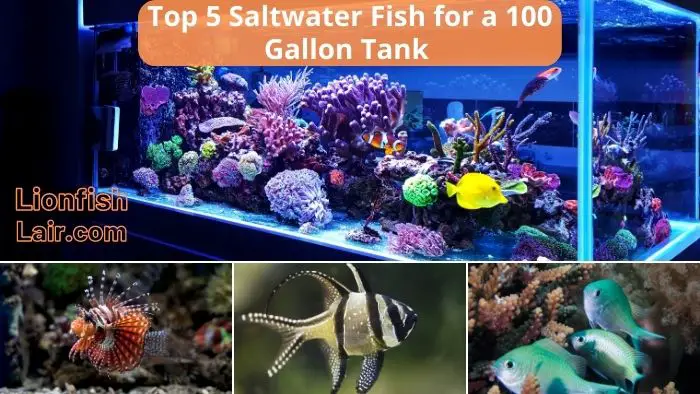
With a good amount of experience in saltwater fish keeping, it is certainly worth owning a 100 gallon (378 liters) tank as you will unlock an abundance of saltwater fish and other incredible marine life that are simply not attainable with smaller tank sizes.
Now, with a tank of this stature, you will be able to take advantage of larger open-water fish, with the addition of some more substrate inhabitants, as well as the usual suspects such as tangs, dwarf angelfish, and wrasses.
Dimensions and Weight of a 100 Gallon Saltwater Fish Tank
The most popular 100-gallon fish tank, and the most typical dimensions you will find measure out at 47.3 inches x 23.6 inches x 19.7 inches (120 cm x 60 cm x 50 cm).
When empty, a 100-gallon tank will typically weigh 180 lbs (81.5 kg), and when full, it can weigh up to 900 lbs (408 kg).
Below you will see these dimensions in a graphical representation for a more visual reference.
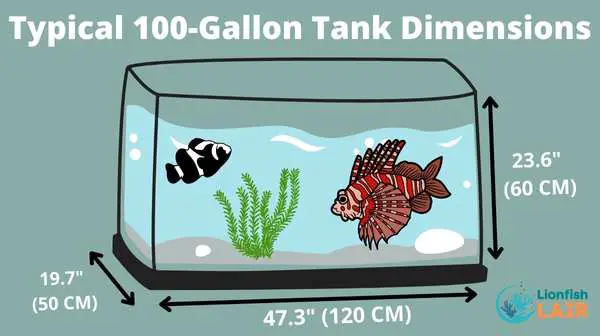
Best Saltwater Fish for a 100 Gallon Tank List
Below is our list of the best fish you can keep in a 100 gallon saltwater fish aquarium. We have mentioned how many of each type of fish you should and can feasibly keep in a fish tank of this size.
You can safely keep a combination of between 20 and 25 of the different types of fish appearing on our list too, and we have chosen fish that are also compatible with each other and that share identical tank requirements.
However, it is important for you to match the difficulty level of each fish to your experience level and also the tank maintenance, which will obviously increase with the more fish you have residing in your aquarium.
Now, enjoy the list - we hope you can get inspired!
1. Lyretail Anthias (1 to 5 Fish)
Lyretail anthias are beautiful, sociable, and active fish, with males showcasing a bright red body and females typically displaying more orange coloration.
What makes them so awesome is that they can be kept in groups, we would advise a maximum of 5 for a 100-gallon tank, but it is important that you keep one male with a group of females due to somewhat aggressive tendencies with the males.
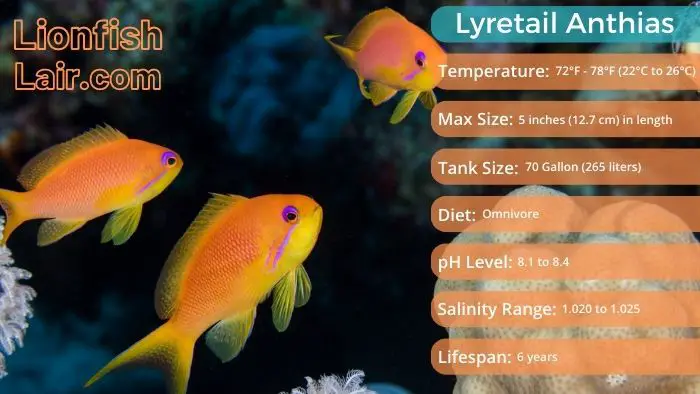
Their social nature makes them brilliant to keep with other types of fish, and due to them being super active, it helps draw out some of the shyer fish. Watching them go about their business in a large aquarium such as the 100-gallon really does provide hours of entertainment.
Here is an overview of lyretail anthias requirements:
- Care level: Moderate
- Temperament: Peaceful/Semi-Aggressive
- Maximum Size: 5 inches (12.7 cm)
- Temperature: 72 - 78°F (22 - 25.5°C)
2. Banggai Cardinalfish (1 to 10 Fish)
If you keep up with our content here at Lionfish Lair, you will know that these are an absolute favorite of ours, and for good reason too! Not only are banggai cardinalfish, or longtail cardinalfish incredibly unique and beautiful in appearance, but they are small enough to keep in big groups too, where they really do thrive.
They display a silver body with white and black stripes that even run across their eyes, which looks awesome! You can keep them in a mixed group of up to 10 fish with this sized tank and they also behave well with other fish. Just make sure that they have plenty of spots around the tank to rest and hide in as they are far smaller than most 100-gallon fish.
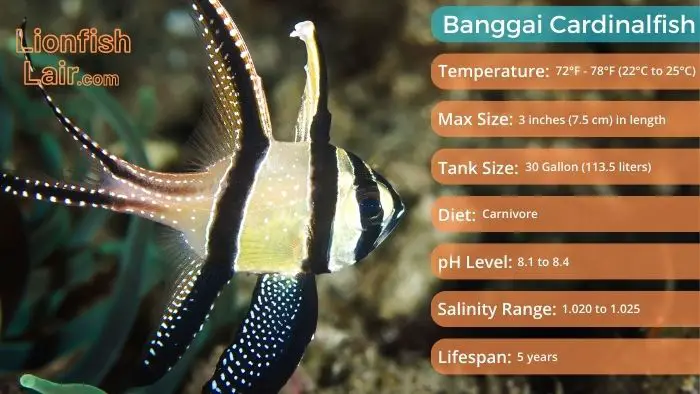
With regards to their behavior, they are predominantly peaceful guys. However, they have been known to sometimes go after each other, but usually, this doesn't last as they become more settled.
Additionally, if it makes you feel better, they have never been aggressive from our experience and have always been model citizens of community tanks. Learn how to care for them properly by checking out our banggai cardinalfish guide.
Here is an overview of banggai cardinalfish requirements:
- Care level: Easy
- Temperament: Peaceful/Semi-Aggressive
- Maximum Size: 3 inches (7.6 cm)
- Temperature: 72 - 78°F (22 - 25.5°C)
3. Fu Manchu Lionfish (1 Fish)
With a 100-gallon aquarium, you unlock all the dwarf lionfish species, however, we wanted to focus on the incredibly quirky-looking fu manchu subspecies! Many people describe lionfish as sporting a somewhat alien appearance, and nothing backs up this theory more than the fu manchu.
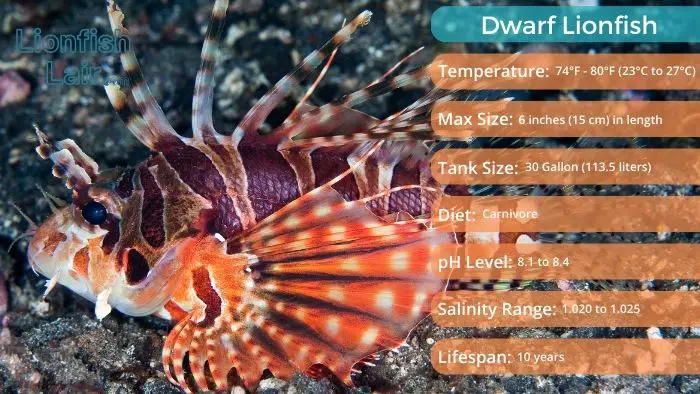
They are lionfish, so are naturally predatory fish, however, they are certainly compatible with the fish on this list as none of them are small enough to be eaten by a fu manchu. Also, once they are used to living in your 100-gallon aquarium and have established a territory, they will behave pretty well, not terrorizing any tank mates, and keeping themselves to themselves, from our experience!
They should be kept alone, however, due to them not getting along well with each other, but they can be housed with a different species of lionfish. For their appearance, they sport a dark-red body with white and light orange stripes and spots. They are also known as "twin spot lionfish" due to the two unique black spots that appear next to their tail fin, which just adds to their uniqueness, oh, and not to mention the feelers that appear underneath their chin!
Here is an overview of fu manchu lionfish requirements:
- Care level: Moderate
- Temperament: Semi-Aggressive
- Maximum Size: 5 inches (12.7 cm)
- Temperature: 72 - 78°F (22 - 25.5°C)
4. Black and White Ocellaris Clownfish (1 to 2 Fish)
If you are a fan of clownfish, which most people are, you will absolutely adore the glorious black and white ocellaris subspecies. They are brilliant fish for a reef tank, as you might imagine with them being clownfish, however, they do not need to be housed with an anemone to thrive.
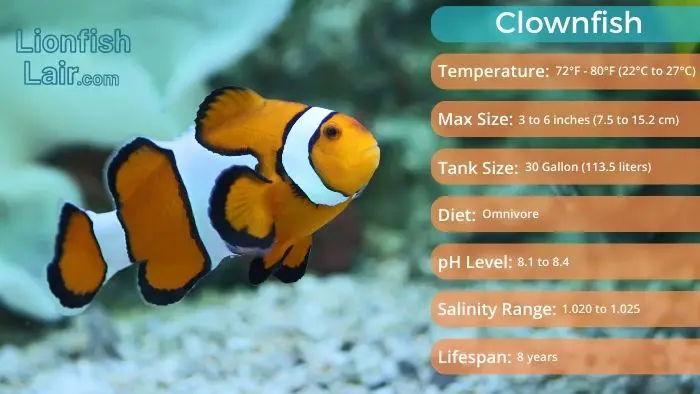
It is good to keep them in pairs, typically of the opposite sex so that they do not behave too aggressively with each other, but they will also do well alone. Their appearance is jet black, with distinctive white stripes on either side. When they are juveniles, they will showcase a dark orange color, which becomes black as they mature.
Just like all other clownfish species, these fellas are extremely hardy, which is perfect for hobbyists with less experience or time on their hands. Additionally, if you are experienced, especially with keeping clownfish, you can keep more than two of them within a 100-gallon aquarium.
Here is an overview of black and white ocellaris clownfish requirements:
- Care level: Easy
- Temperament: Peaceful
- Maximum Size: 3 inches (7.6 cm)
- Temperature: 72 - 78°F (22 - 25.5°C)
5. Blue Green Reef Chromis (1 to 10 Fish)
These fish are some of our favorites as they are so easy to care for! Not to mention, they are beautiful and have an extremely peaceful temperament, which is great when you want to create a harmonious 100-gallon reef aquarium environment.
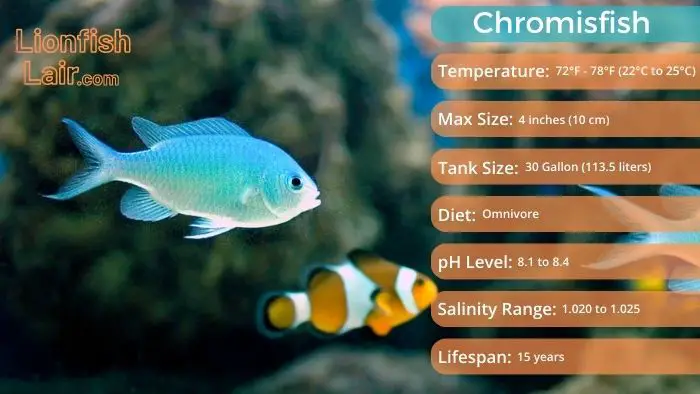
Blue green reef chromis fish, as the name might suggest, sport a blue and green, almost chrome coloration. They should be kept in groups of their own and are compatible with literally any saltwater fish you keep them with. You will see them darting around your tank in the open spaces, and they love socializing with their own, and their tank mates.
Despite being technically damselfish, they are not aggressive fish at all and can even be housed with crabs, shrimp, and other invertebrates without running the risk of them being eaten. They are extremely hardy fish too and can live for up to 15 years if cared for correctly.
Here is an overview of blue green reef chromis requirements:
- Care level: Easy
- Temperament: Peaceful
- Maximum Size: 4 inches (10 cm)
- Temperature: 72 - 78°F (22 - 25.5°C)
Before Setting Up Your 100 Gallon Aquarium
There are some careful considerations you need to take into account before setting up and adding the fish to your new 100 gallon (378 liters) fish tank.
Quarantine Your New Fish
It is crucial that you quarantine your new fish arrivals before introducing them to your aquarium. Due to the size of the tank, chances are you will be adding a fair few different fish and probably at different times too.
Due to this, some of your new fish may be carrying parasites, or as we like to call them, aquarium hitchhikers. And you certainly do not want harmful hitchhikers in your tank as they can slowly kill your fish and will spread like wildfire, infecting all inhabitants, even some of the hardier residents.
If you do accidentally have a parasite-infected fish residing in your 100 gallon (378 liters) tank, it can be incredibly difficult to catch it to begin treatment due to the sheer size of the aquarium!
Handling the Aggression of Your Fish
Obviously, the fish that we have chosen from this list are from our own experiences and have never acted aggressively toward each other with our care, or with other hobbyists that we have spoken to. However, this isn't to say that they won't be for you.
Fish are not always easily predictable; you could have a notoriously peaceful fish become one of the biggest tank bullies in your tank - there are always anomalies!
So, the best thing to do is to introduce the more peaceful and timid fish first, and then the more aggressive ones afterward, this way, your peaceful fish will have established a territory and will be more used to their surroundings.
Doing things this way almost always ensures compatibility within your tank.
Required Equipment for a 100-Gallon Aquarium
Here is all of the equipment you need for a 100-gallon saltwater aquarium:
- Lights
- Heater
- Chiller
- MP-40 or Gyre pump
- Protein skimmer
- Test kits
- Lid
- Quarantine tank
Other Popular Tank Sizes
It is totally understandable that for many hobbyists, 100 gallons (378 liters) is simply not a realistic aquarium size, especially if you are a beginner. So, below are some links to fish lists for some smaller-sized saltwater fish tanks:
Alternatively, if you are looking for options for an even larger aquarium, maybe a 125 gallon saltwater fish list is more suitable for you.
Final Thoughts
We hope you have enjoyed our detailed list of the most compatible fish for your new 100 gallon (378 liters) saltwater fish tank.
Additionally, we understand that you may not like all or any of our choices, so, if you are looking to come up with your own fish, just ensure that they have the same temperature and tank requirements and are compatible with the rest of the fish you wish to keep. Good luck!

